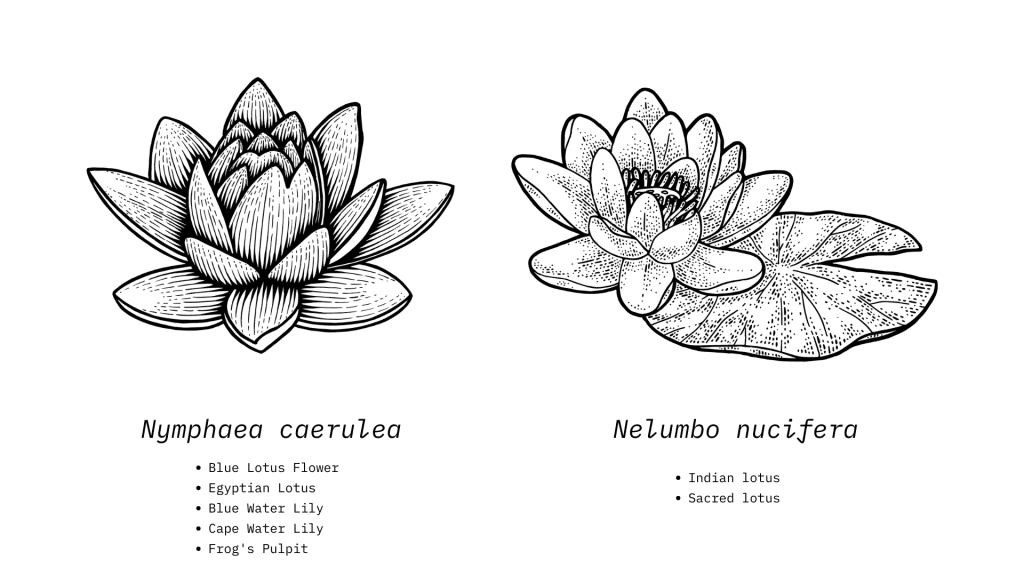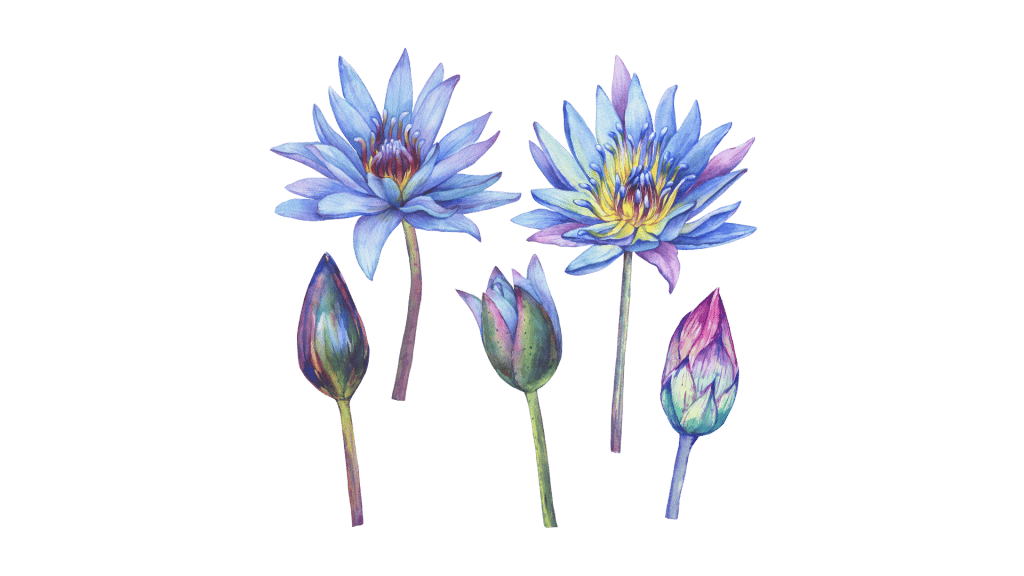- Joined
- Nov 23, 2022
- Messages
- 36
- Reaction score
- 38
- Points
- 18
What is Blue Lotus Flower?
Blue lotus (Nymphaea caerulea) is an aquatic plant found in freshwater ponds and lakes around Eastern Africa.
The flower of the blue lotus was closely associated with the sun. In the morning, when the sun rises, the petals open. At night, when the sun goes down, the petals close again. Because of this, the ancient Egyptians believed it to be intimately connected with the sun god Ra.
Blue lotus is also able to thrive in the muddy, oxygen-deprived soil at the bottom of lakes and ponds where no other plants can grow. It was believed that the world was created from a blossoming blue lotus flower that sprouted from the otherwise sterile primal waters.
On top of the metaphorical references, blue lotus flower has psychoactive properties that highlight its spiritual significance. It contains two key alkaloids with psychotropic effects — aporphine and nuciferine. Both of these compounds have opioid-like activity and induce a trance-like state of consciousness.
Note: Blue lotus flower (Nymphaea caerulea) shouldn’t be confused with the sacred lotus flower (Nelumbo nucifera). While both plants contain the compound nuciferine, these plants are not considered interchangeable and do not have same effects.

Blue Lotus: Specs & Technical Details
| Active Ingredients | Aporphine (Apomorphine) & Nuciferine |
| Level of Risk | Low |
| Common Names | Blue Lotus Flower, Egyptian Lotus, Blue Water Lily, Cape Water Lily, Frog’s Pulpit |
| Most Common Side-Effects | Sedation, catalepsy, respiratory depression |
| Duration of Effects | 4–6 hours |
| Legality | Legal in most parts of the world. Illegal in Russia & Poland |
What Are The Active Ingredients In Blue Lotus Flower?
The active ingredients in blue lotus flower — aporphine and nuciferine — are classified as isoquinoline alkaloids.
This makes them chemically related to benzylisoquinoline alkaloids such as morphine and codeine, as well as the antimicrobials sanguinarine and berberine [1].
1. Aporphine & Apomorphine
Aporphine is the most basic member of the larger aporphine alkaloid classification — which includes nuciferine, nymphaeine, nymphaline, nupharine, α- and β-nupharidine — all of which are found in the water-lilly genus (Nymphaea).
Once inside the body, aporphine is converted to apomorphine, which shares many structural similarities with morphine.
Apomorphine is used as a drug for treating Parkinson’s disease, alcoholism, drug addiction, and erectile dysfunction under the brand name Apokyn.
Apomorphine has been shown to have the following pharmacological actions [3,4]:
- Nonselective dopamine receptor (primarily D2) agonist
- 5-HT2 receptor agonist
- α-adrenergic receptor agonist
2. Nuciferine
Nuciferine is another type of aporphine alkaloids found throughout the Nymphaea genus of plants. It’s most abundant in the Nymphaea caerulea species.
This compound is also found in another species called Nelumbo nucifera (sacred lotus) found throughout central Asia.
The effects of nuciferine are still being studied, but so far, researchers have discovered this compound shares striking similarities with aripiprazole-like antipsychotic drugs.
Nuciferine has been shown to have the following pharmacological actions [5]:
- 5-HT2A, 5-HT2C, & 5-HT2B antagonist
- 5-HT7 inverse agonist
- Partial D2, D5, & 5-HT6 agonist
- 5-HT1A agonist
- Dopamine transporter inhibitor
3. Other Ingredients
Blue lotus flower also contains an impressive collection of antioxidants, including various flavonoids, quercetin, kaempferol, gallic acid, and myricetin (antioxidants) [7].
The essential oil content of the plant contains high concentrations of a triterpene called squalene, which is a popular ingredient for skincare products because of its role in lubricating and protecting the skin.

How to Use Blue Lotus Flower
Traditionally, blue lotus flower was brewed into a strong tea.
While this method remains viable today, there also are also other, more efficient methods of using this plant.
Please note, the safety profile of the blue lotus flower has not yet been confirmed. Due to the narcotic and potentially addictive qualities of apomorphine, the risk of ***** with this herbal extract is likely — especially when using the concentrated absolute in a vaporizer.
1. Blue Lotus Flower Tea
The easiest way to use the blue lotus flower is to prepare it as tea:
- Heat your water just before boiling and add about two tablespoons of dried blue lotus flower into a strainer.
- Pour your hot water over the tea and cover it.
- Allow the tea to infuse for about 5 minutes before drinking.
The Blue lotus flower has a high concentration of essential oils. If you want to maintain the incredible fragrance of this tea, it’s important to use water that isn’t quite boiling (80ºC is optimal) and cover the mug while you let it steep. This reduces the amount of volatile oils that are able to escape while you prepare your tea.
You can flavor the tea as needed with honey, agave nectar, or sugar, but it has already has a pleasant taste on its own.
2. RDA Vaporizers
Blue lotus flower resins are sometimes used in a specialized device called an RDA vape.
RDA stands for “rebuildable dripping atomizer.” They’re a special kind of vape that allows resins to be added directly to the heating coil. They don’t contain a reservoir, and thus the blue lotus flower resin must be dripped onto the coil every so often.
The resin is then vaporized and inhaled, where it’s rapidly absorbed through the lungs.
Studies have confirmed that both apomorphine and nuciferine remain viable during the atomization process and can be inhaled for more efficient delivery [6].
3. Blue Lotus Flower Absolute
Most essential oils are extracted using a process called steam distillation. However, some plants, including blue lotus flower, jasmine, and ylang-ylang, are extracted using solvents instead.
This process yields an extract called an absolute, which is thicker and stronger than conventional essential oils.
Blue lotus absolute is often used in making skincare products, perfumes, and incense. It has a light floral aroma somewhat similar to ylang-ylang, but not quite as floral and with a mild spicy component.
4. Alcoholic Tinctures & Infusions
Blue lotus flower was often infused into alcoholic beverages as a way to preserve the aroma and active constituents of the plant long-term.
While it’s uncommon to find blue lotus-infused wines or spirits, they’re easy to make at home by simply soaking dried blue lotus flower in a bottle of vodka or alcoholic spirit of your choice for several weeks before straining out the plant matter.
References
- Hagel, J. M., & Facchini, P. J. (2013). Benzylisoquinoline alkaloid metabolism: a century of discovery and a brave new world. Plant and Cell Physiology, 54(5), 647-672.
- Jia-Qing, Q. I. A. N. (2002). Cardiovascular pharmacological effects of bisbenzylisoquinoline alkaloid derivatives. Acta Pharmacol Sin, 23, 1086-92.
- Millan, M. J., Maiofiss, L., Cussac, D., Audinot, V., Boutin, J. A., & Newman-Tancredi, A. (2002). Differential actions of antiparkinson agents at multiple classes of monoaminergic receptor. I. A multivariate analysis of the binding profiles of 14 drugs at 21 native and cloned human receptor subtypes. Journal of Pharmacology and Experimental The*****utics, 303(2), 791-804.
- LeWitt, P. A. (2004). Subcutaneously administered apomorphine: pharmacokinetics and metabolism. Neurology, 62(6 suppl 4), S8-S11.
- Farrell, M. S., McCorvy, J. D., Huang, X. P., Urban, D. J., White, K. L., Giguere, P. M., … & Roth, B. L. (2016). In vitro and in vivo characterization of the alkaloid nuciferine. PLoS One, 11(3), e0150602.
- Poklis, J. L., Mulder, H. A., Halquist, M. S., Wolf, C. E., Poklis, A., & Peace, M. R. (2017). The blue lotus flower (Nymphea caerulea) resin used in a new type of electronic cigarette, the rebuildable dripping atomizer. Journal of psychoactive drugs, 49(3), 175-181.
- Agnihotri, V. K., ElSohly, H. N., Khan, S. I., Smillie, T. J., Khan, I. A., & Walker, L. A. (2008). Antioxidant constituents of Nymphaea caerulea flowers. Phytochemistry, 69(10), 2061-2066.
- Dey, P., Kundu, A., Kumar, A., Gupta, M., Lee, B. M., Bhakta, T., … & Kim, H. S. (2020). Analysis of alkaloids (indole alkaloids, isoquinoline alkaloids, tropane alkaloids). In Recent advances in natural products analysis (pp. 505-567). Elsevier.
(Trtipsitter)
